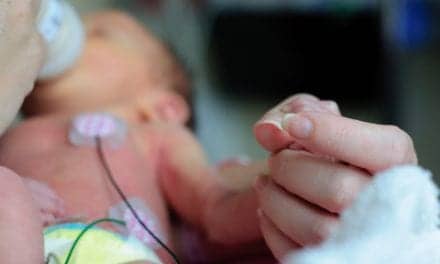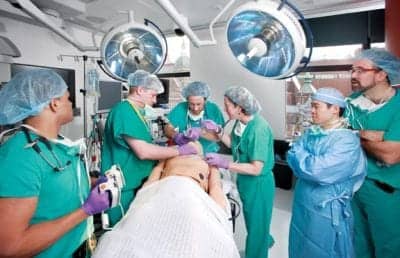At Shriners Children’s Hospital in Cincinnati, RTs regularly fly far and wide to bring back severely burned children to the hospital for free medical care.
 |
| Jennifer Melton, RRT, and Mike Riggs, RRT, transport a critical burn patient via fixed-wing airplane. |
Being a respiratory therapist at Shriners Hospitals for Children– Cincinnati can be challenging at times. Not only must Shriners’ RTs be ready to board a medical air transport at a moment’s notice, but they also must also be cross-trained with additional nursing skills, be a pro at airway management for pediatric tracheotomies, and make time for research and continuing education. The Shriners RTs may not be superheroes, but they do fly to the rescue.
The Shriners’ Cincinnati hospital is one of a network of 22 facilities that provides specialized orthopedic, spinal cord injury, and burn-injury care to children, 18 and younger. The Cincinnati unit focuses exclusively on pediatric burn cases and serves the Cincinnati area and anywhere else its air-transport team can fly—generally within the Midwest and southeastern parts of the United States.
Part of the Shriners’ mission is to provide medical care at no cost to the patient or family, without regard to financial need or relationship to a Shriner. Surprisingly, the hospital system receives no government assistance but is, instead, dependent on its multimillion-dollar endowment and donations from Shriner members, their temples, and the public to fund its hospitals and programs.
“The Shriners organization pays for all of our hospital operations, all of our salaries, and all the patient care,” says Carl Scheiner, BSEd, RRT, ATC, senior respiratory therapist at the burn unit. “That’s a really nice thing about working here—it doesn’t come down to the bottom line. We’re definitely patient care-driven.”
The hospital’s 30-bed facility is supported by 11 RTs and one registered polysomnographic technician, who conducts full pediatric sleep studies. The entire RT unit is led by medical director and anesthesiologist John McCall, MD, who received his fellowship in pediatric anesthesia at the University of Cincinnati College of Medicine and is a diplomate of the American Board of Anesthesiologists.
Air RTs
 |
| Rick Hotchkiss, RRT, participates in an annual airway day education seminar. |
Providing quality free care is just one example of the Cincinnati burn center’s commitment to young burn victims: The hospital goes one step—or thousands of miles—further by providing free medical air-transport services.
All 11 RTs are members of the pediatric burn air transport team, which covers more than 20 states, from the Midwest down to Florida. Scheiner says that being on call for air transport is part of their job requirement, so any RT who is afraid to fly need not apply.
Air transport calls can come in day or night. Sometimes the calls come in through a Shriner or a Shriner temple community that has seen a news item about a child who has been burned. Referrals also come directly from a parent who has heard about the Shriners’ program. Referrals do not have to come through a Shriner organization. Anyone can apply, 24/7, by going to the Shriners’ Web site and submitting an online application.
After receiving the referral, the burn unit’s air-transport coordinator—a registered nurse—contacts the attending physicians to have them sign off on the transfer and coordinates with the hospital-of-origin to release the patient. Then the on-call nurse and RT are assembled and can be in flight within about 2.5 hours after the call.
The Shriners’ air RTs do not have to know how to fly a jet. Instead, the burn unit charters Lear jets or Cessnas that have been specially designed for medical transport. These planes are typically equipped with a stretcher and all necessary medical gear, including ventilators and monitoring machines.
Before going on full calls, RTs have a lengthy orientation about the onboard equipment and emergency procedures. For additional air-transport training, an RT can take the Transport Nurse Advanced Trauma Course (TNATC), a class developed by the Air & Surface Transport Nurses Association.
Scheiner says, “We’re kind of cross-trained. We have to be familiar with all of the nursing equipment, to help [the RNs] if there are any [problems] on their end. But it works vice versa too. The nurses also have to be trained on our ventilator and other equipment in case there are some issues with us or with our equipment.”
Once arriving at the child’s origin city, the Shriners team stabilizes the patient for transport back to Cincinnati.
Parents are welcomed and encouraged to stay with their child in the hospital rooms, which have built-in beds for family members, as well as optional roll-a-ways to handle additional family members. For severely burned children who are in the ICU, the hospital also provides hotel-like suites within the building. Additionally, a nearby “parent house” is available for extended stays. As with all of Shriners’ services, accommodations and housing are free of charge.
Day in the Life at the Pediatric Burn Unit
 |
| (L-R) Jennifer Melton, RRT; Robert Smith, RPSGT; Ken Olding, RRT; Carl Scheiner, RRT; and Stephanie Harris, RRT, with the hospital’s 5th consecutive Quality Respiratory Care Recognition Award from the AARC. |
Once the patient is transported safely to Cincinnati, the RT’s really difficult work begins.
Scheiner and his coworkers see all types of burns, from car fires and household fires, to electrical and chemical burns. Treatment often involves some kind of skin grafting and many dressing changes over the course of weeks, if not months.
RTs are responsible for monitoring these dressing changes due to the respiratory risks involved with pain medication that is given during the process. A conscious-sedation drug, such as ketamine, carries the risk of closing off the respiratory tract, so RTs must carefully observe the sedative’s administration and maintain the airway throughout each dressing change.
For those patients who cannot tolerate ketamine dressing changes, RTs are responsible for administering nitrous oxide. Scheiner says that on a busy day there may be eight or nine dressing changes throughout the hospital.
Another part of the RT’s tasks is to monitor inhalation injuries from breathing in hot air, which can cause a burn injury to the airway.
Scheiner explains, “With children who have that type of injury, especially small children, we’ll put them on an oscillating ventilator—the Bird volume diffusive respirator (VDR) ventilator. We’ll place them on that to give them a bit of percussion to help break up some of the mucous. [As well], the lining of the airway tends to slough off, and [the VDR] helps to break that up and get it out.”
While ventilation machines may be common tools for RTs, Shriner RTs must also be familiar with ultrasound in order to assist physicians during arterial line changes. In addition, they supervise all of the metabolic monitoring at night and report the results to the nutrition department. Of course, their daily duties also include performing full and bedside pulmonary function tests (PFTs).
Some of these daily PFTs may include familiar faces from the past. Burn victims—especially young ones—can have long-term respiratory complications that require follow-up visits for many years after being discharged. For example, if a child is burned on the abdomen or has a certain type of burn that goes around their body, the damage can have an effect similar to COPD. The loss of skin elasticity may not allow the child to take a deep breath, which can cause an obstruction.
Shriner RTs are also involved with helping former patients reenter their schools when, for example, the patient goes home with a tracheostomy. Scheiner says, “Before that child returns to school, we go and speak to all the students at the school and to all the teachers and to the nurse, just to make things as easy as possible for that child when they get back to school.”
Research
 |
| Shriners Children’s Hospital in Cincinnati. |
In addition to its dedication to giving children free high-quality health care, the Shriners organization is also devoted to performing medical research at its hospitals. Past research from the hospital has included developing innovative medical devices, such as a unique burn patient feeding tube system and growing cultured skin from a patient’s biopsy.
Research is playing an even larger role at the hospital since its chief of staff, Richard J. Kagan, MD, FACS, became president of the American Burn Association in 2007. Scheiner says that every department at the hospital is working diligently to turn out a significant amount of research this year to support Kagan’s presidency.
“We’re all involved,” says Scheiner. “Even though we’re a respiratory department, there’s definitely some intermingling between all of the departments. We could have a person in our department doing something for the nutrition department, like our sleep tech; he does a lot of research for nutrition while running sleep studies and running metabolics.”
Currently, Scheiner’s RT department is performing retrospective studies of the effects of decannulation and the long-term effects patients may experience after having a tracheostomy.
Training and Teaching
Being a burn-unit RT at Shriners takes more training than one might need in a typical hospital setting. In addition to the air-transport orientation, RTs are required to pass several burn-injury-related courses.
For training specifically on burns, all Shriner RTs are Advanced Burn Life Support (ABLS) certified. This is in addition to Advanced Cardiac Life Support (ACLS), Pediatric Advanced Life Support (PALS), and Basic Life Support (BLS) certifications. RTs may also opt to take Advanced Trauma Life Support (ATLS) training. The costs of all of the unit’s required and optional training courses are covered by the hospital.
The hospital is also involved in teaching burn courses to several local community colleges.
Handling It All
Between normal RT responsibilities, training, air transport, research, and all the interdepartmental support, RTs at the hospital seem to have their hands full. And yet, the workload has not affected the quality of care. Cincinnati’s RT department has received the Quality Respiratory Care Recognition Award from the American Association for Respiratory Care (AARC) for 5 years in a row.
Of all of the RTs’ responsibilities, perhaps their most challenging—and most important—is being able to treat a young burn victim like a normal child. That can be even more difficult when the RT is a parent. But eventually, the hospital staff learns to concentrate on the child behind the injuries.
“After a while, you start to see them and look past the burns,” says Scheiner. “You can focus on them just being a regular kid. It just takes a little time.”
Asked about how they can keep up with all of their various duties, Scheiner says, “We’re a small department with a lot of responsibilities. I think that’s the key. We stay a close, tight-knit group and rely on each other.”
Tor Valenza is a staff writer for RT. For further information contact [email protected].










